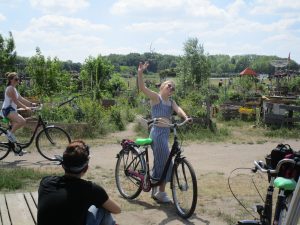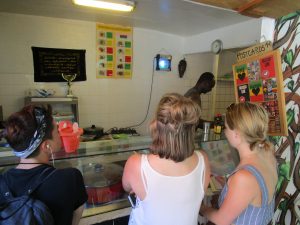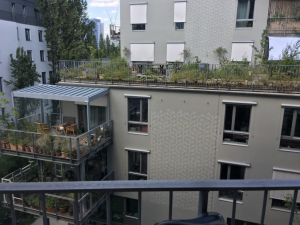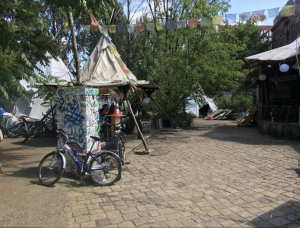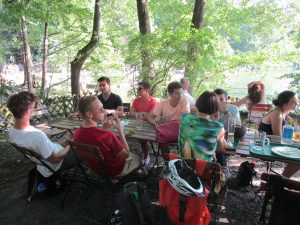In the morning we had the opportunity to meet with Karin Franzen from GIZ (Gesellschaft für Internationale Zusammenarbeit, essentially the German international development agency). She focused on the Energiewende in Germany and how their knowledge has been transferred to and involves China. In fact, GIZ works with countries around the world to implement aspects of the German Energiewende in other nations’ political, social, and economic systems. This presentation was incredibly interesting for showing how German ideas and the energy transition can be applied on a global scale, and how to build infrastructure and institutions in other countries that need it greatly.
What really piqued my interest was Franzen’s views on GIZ’s relationship to the US now that Trump is president. She argued that Trump’s withdrawal from the Paris Agreement was not necessarily negative, however that it has changed the way GIZ goes about interacting with the States. She reported that German government officials were finding it very difficult to get any response from American government agencies. Although US officials were present at the G20 meetings, they remained close-lipped. GIZ has begun to seek alternative paths, such as direct contact to individual states (think California, for example), to create positive, environmental impact in the US. Because their mission is so closely related to the Paris Agreement and each specific nation’s goals, GIZ in turn involves national governments directly more than before. I found this entire process of international diplomacy riveting and in fact positive.
I think that this trip for me has been a constant roller-coaster of optimism and fear. Optimism comes from the pragmatic and forward-thinking solutions of the Netherlands, Germany and other relatively small European countries. In learning about and discussing these solutions, fear follows when I think about how much more needs to be done to combat climate change and how far behind the United States, my home, seems to be.
Franzen’s discussion allowed the roller-coaster to rest (however briefly) in a state of optimism by showing the outreach and discussion that are occurring between Germany and larger, more dynamic countries similar to the United States. While the Trump administration does not show the same initiative to combat climate change as the Chinese government does, the fact that solutions are being implemented in Chinese cities easily the size of Los Angeles and Manhattan gave a hopeful beat to the discussion.
The discussion about the Chinese efforts to end climate change are also incredibly interesting in how they contrast with the German Energiewende. The German citizens started a grass-roots movement toward sustainable energy and development, and the legislation followed. In China, the powerful government is developing a top down approach. Franzen explained that it was exciting to work with China because when an idea is proposed, the government has the power and capacity to implement these solutions and see if they work, rather than face the gridlock of a multi-faceted government. It’s difficult to tell which one is more effective.
Franzen specifically mentioned some interesting points regarding the large and immediate scale of China’s recent “Energy Revolution.” Germany needs far more discussion to change their situation, but China has used its recent motivations to create Bilateral Energy Partnerships to experiment with cutting edge Green technology, largely because they can see the effects of pollution and climate change more on a daily basis than much of the rest of the world. Franzen ended her discussion of China’s changes with a serious and somber statement on the difficulties of climate change today. The world isn’t moving fast enough to combat the temperature rise occurring globally, but when asked about her optimism that China could make a serious difference, she said, “If not China, then who?”
The collective spirit and loud voice of the German citizens propelled them into the Energiwende quickly and efficiently, but now the Green movement faces roadblocks in the form of a multi-party coalition government with conflicting priorities. China, on the other hand, has the capacity to move just as quickly with governmental innovation, and it will be interesting to see if China faces “growing pains” in the form of citizen opposition or other sidesteps. I am also curious to see how significantly the catch-up effect is impacting China’s Green growth. In general, the application in China really interested me, and while the Chinese government differs greatly from the United States, the scale of the projects in these mega cities provides hope that what works in China can be implemented in the United States. And it is reassuring to see that China is making grand efforts to combat its intense and dangerous air pollution.
After the talk with Franzen, we rented bikes and rode to the decommissioned airport, Berlin Tempelhof. In awe of the sprawling undeveloped space in the middle of the city, we biked down runways built for planes and saw the airport, once the largest building in Europe on the airfield used during the Berlin Airlift to keep the citizens of West Berlin supplied with food in 1948-49 in the beginning of the Cold War. It was unreal to see so much public space for a person coming from a country that values private development and expansion so that such a space would have been paved over and built on immediately. The Berlin government meant to allow the space to be developed and a sustainable, mixed-use plan with due consideration for low-rent housing had been approved. A citizen revolt in the form of a referendum and vote completely upended the government’s plans and Tempelhof remains undeveloped and accessible to citizens who have no problems imagining how to make use of it. It was inspiring to be in a place, filled with friends and a historic, collective, GREEN energy that was truly created by the people for the overall community!
We also got to see the beginning stages of some temporary housing for 1,300 refugees, adding another layer to Tempelhof’s storied history. Last year, Germany took in 1,000,000 refugees! Seeing the small pods that these families would live in gave some perspective, and I began to think about how to many people the clean energy transition is a low priority when it comes to other social issues. I often find myself surprised and devastated when I really think about how leadership is shying away from combating climate change despite the overwhelming scientific evidence. Seeing the refugee camps in between our discussions of the Energiewende reaffirmed that there are so many life-threatening issues and complex, international problems. For some, climate change and clean energy are at the top of the list. For others, simply surviving comes before these issues.
Yet, at the end of the day, what I think we all learned is that these issues are closely related. Climate change is going to impact our survival, especially as it affects those in areas where people are already beginning to migrate. Areas like Syria, where many refugees are fleeing from, are already experiencing drastic climatic effects that will only get worse and multiply the refugee crisis if we as a united world do not stop the global rise in temperatures. In turn, although being in Tempelhof, on first thought, seemed like a random pit stop in an otherwise focused trip, the future refugee camps at this airport are directly related to our subject matter of international environmental policy.
We ate lunch at YAAM, the Young African Art Market, an improvised club, gallery, and restaurant on the “beach” of the Spree River, part of Berlin’s extensive grey market. We were met there by Michael LaFond, director of the Institute for Creative Sustainability, and expert in co-housing. He took us on a quick walk-through of Teepee Land, a self-proclaimed independent area within the larger city of Berlin that has existed for about five years. The approximately 50 permanent residents of Teepee Land are totally off-grid, occupying prime riverfront real estate, living by the rules of their own constitution, tolerated by the police. It was nice to see acts of rebellion and resistance at all levels throughout the trip, and Teepee Land was no exception. Seeing people live their lives, while consciously caring about their land, inspired our group.
Afterwards, we would up at LaFond’s cooperative ID 22. After biking through a bustling city and narrowly avoiding speeding cars, the institute felt like a quiet oasis tucked away. In reality, less than a two minute walk led us back out to those busy streets and the metropolis. LaFond’s cooperative proposed interesting ideas on urban development and growth. Co-living and co-housing provide a unique solution to the demand for housing, but with sustainable attributes that are inherently ingrained in the structure of a cooperative. In my opinion, sharing space and sharing resources in close quarters lead to the idea that nothing should go to waste. It allows for the residents to become conscious of how and where they get their food, their energy and their supplies. With this consciousness comes a secondary responsibility to gain these resources in the most effective and sustainable way possible, as it’s integral to continue their way of life. While LaFond focused more on the benefits, construction and design of his cooperative project, the sustainable principles that they implemented seemed like an obvious part of the discussion. No one needed to ask why he was planting fruit trees and developing a garden, or why they dug deep into the ground for thermal energy. These practices were regarded amongst the group and LaFond as part of co-living. In most other urban areas, and in many people’s lives, living is separate. Separation from your neighbors is regarded as integral to a home, and this helps create the individuality that hinders collective growth and discussion.
These cooperatives, popping up in different places around Berlin, showcase possibilities for a shared and green lifestyle in big cities like Berlin without breaking the bank. People of all environments can come together and stay in these communities, as long as they contribute to keeping the shared places clean and positive. However, Lafond did admit that while cooperatives like his were working very well, it is not for everyone. Some people may need more privacy for living, or are not able to respect a shared living area and create more work for others as a consequence. The people who did live in the cooperative, though, largely appeared to go above and beyond what is required. Throughout the area, families had built children’s toys and learning tools in the open air community spaces, ensuring that such a shared place can be friendly to all ages and develop an environment that is still nurturing.
Teepee Land was also incredibly interesting as it pointed once again to the difference between how the Germans treat the community and land as opposed to the United States. A collection of make-shift teepees squatting on public land in the United States would be shut-down before it could likely even begin. While LaFond did mention that urban development was threatening Teepee Land, he did explain that it would be difficult to kick out the people living there and actually develop that land.
Overall, the day was a more optimistic one when it comes to thinking about sustainable developments and combatting climate change on a global scale. Sustainable solutions are being presented and applied in larger cities, and China is committed to lowering their emissions with help from German experts like GIZ. Not only was riding around Tempelhof an incredibly fun way to spend the afternoon, it also showed the ability for a public to organize and promote their interests and a government willing to listen. While it may seem like the United States is increasingly far away from sustainable measures, the fact that innovations and differences are occurring all around the world provides a sense of hope.
It was hot and the day was not done. The last item on our list was a train ride to a beer garden on Schlachtensee, one of the many inland lakes within metropolitan Berlin. Under the shade of trees, we met up with Penn-abroad students who had been in Berlin since March, and watched Berliners cool off in the lake. A number of us resolved to be among the bathers the next day!
Annalies








